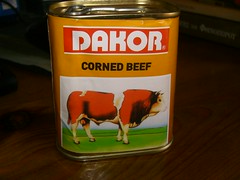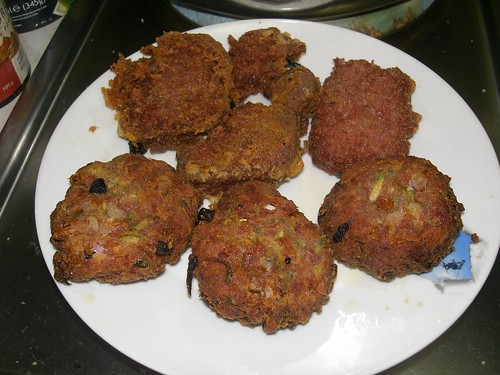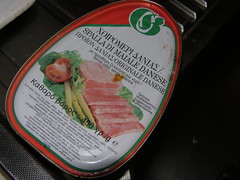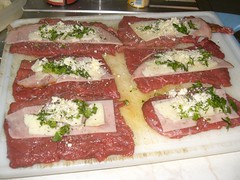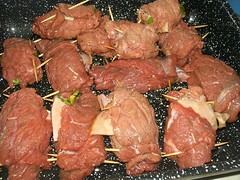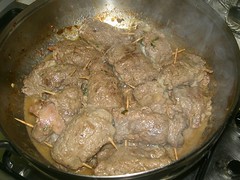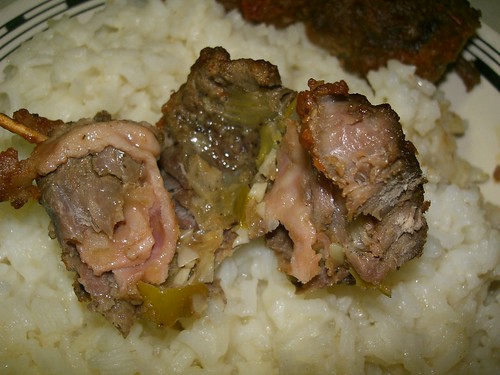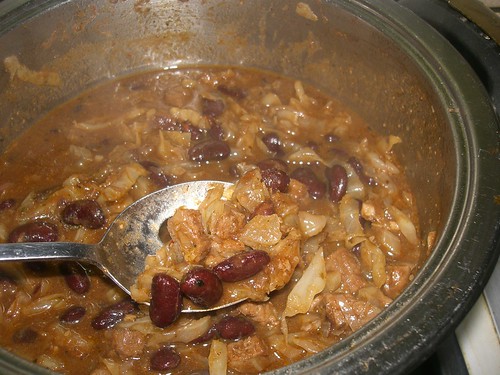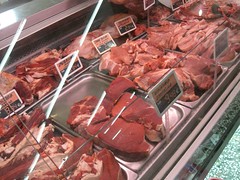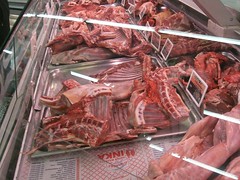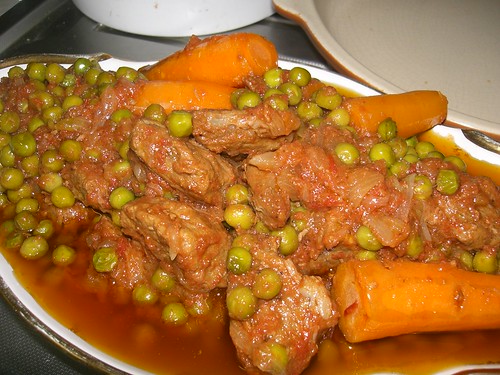My life is very busy as of late, noticeable by the times I don't go to the supermarket. Last Saturday, rather than traipse around town buying from my regular small-scale suppliers, I decided that life felt too short at this moment in time, to actively support the local shopowners, who I adore because they know me and my sharp observation skills, and I know them and their pass-one-over methods, and I get some great conversations out of them. So I headed down to the local supermarket to do the weekly shop and to pick up some meat for Sunday lunch while I was there.
Supermarket meat is often sold more expensively (at least, here in Hania) than small-shop meat, so I was aware that I would be spending more money in this setting. I wanted some mince for my freezer bifteki: Greek beef - €10.98/kg, Belgian beef - €9.59/kg. The Greek beef looked pinky-red, like it usually does, because it rarely allowed to 'sit' for longer than 2-3 days before it's sold, The Belgian meat looked just a little darker, but I preferred the shape of the cut. I chose the Belgian beef over the Greek, mixing in some Cretan pork (€6.78/kg) into the mince mixture - remember that in Crete, it is far more common to buy fresh mince that is prepared before you after you have chosen the pieces of meat that will be minced for you.
While I was at the supermarket yesterday, I also found US Black Angus at the same meat counter, selling at €9.69/kg. Like the Belgian beef, it was cheaper than Greek beef. Black Angus is one of the most highly rated beef products in the world, and we can get it for LESS than Greek beef! I've never tried Black Angus before, so I thought it was time we did. I asked the butcher to cut me three large slices.
I'm not sure what the problem is with Greek beef. Over time, it has developed a better texture. It's not as stringy as the foregin stuff. But you still can't cook it in a pan, like you can do with Black Angus. Although I'm not still convinced that beef should be eaten medium-rare with its pink colour, for the first time in my life, I am cooking beef in Greece in the oven, and I can already feel how tender it is, as the knife slides through so easily.
My first foray into Black Angus will be in a Greek-style recipe. After pan-searing the fillets, I placed them in the oven in a tomato-based sauce with the regular seasoning. It's cooking now. My husband keeps asking me: "Are you sure this will be edible?" Greek beef still has that nasty reputation of being tough. It needs a facelift if it's going to survive in this money-poor world, when cheap foreign imports are invading its domain.

UPDATE:
Black Angus stays tender throughout the cooking period and it is very juicy. But it lacks the aroma of Greek-raised meat. I guess it's true that you are what you eat - if grazing animals eat aromatic plants, their meat smells like it too.
©All Rights Reserved/Organically cooked. No part of this blog may be reproduced and/or copied by any means without prior consent from Maria Verivaki.
Supermarket meat is often sold more expensively (at least, here in Hania) than small-shop meat, so I was aware that I would be spending more money in this setting. I wanted some mince for my freezer bifteki: Greek beef - €10.98/kg, Belgian beef - €9.59/kg. The Greek beef looked pinky-red, like it usually does, because it rarely allowed to 'sit' for longer than 2-3 days before it's sold, The Belgian meat looked just a little darker, but I preferred the shape of the cut. I chose the Belgian beef over the Greek, mixing in some Cretan pork (€6.78/kg) into the mince mixture - remember that in Crete, it is far more common to buy fresh mince that is prepared before you after you have chosen the pieces of meat that will be minced for you.
While I was at the supermarket yesterday, I also found US Black Angus at the same meat counter, selling at €9.69/kg. Like the Belgian beef, it was cheaper than Greek beef. Black Angus is one of the most highly rated beef products in the world, and we can get it for LESS than Greek beef! I've never tried Black Angus before, so I thought it was time we did. I asked the butcher to cut me three large slices.
I'm not sure what the problem is with Greek beef. Over time, it has developed a better texture. It's not as stringy as the foregin stuff. But you still can't cook it in a pan, like you can do with Black Angus. Although I'm not still convinced that beef should be eaten medium-rare with its pink colour, for the first time in my life, I am cooking beef in Greece in the oven, and I can already feel how tender it is, as the knife slides through so easily.

UPDATE:
Black Angus stays tender throughout the cooking period and it is very juicy. But it lacks the aroma of Greek-raised meat. I guess it's true that you are what you eat - if grazing animals eat aromatic plants, their meat smells like it too.
©All Rights Reserved/Organically cooked. No part of this blog may be reproduced and/or copied by any means without prior consent from Maria Verivaki.







